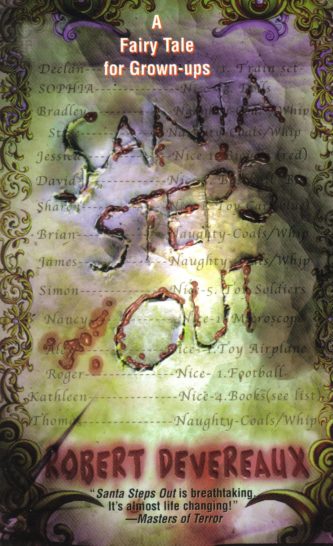 By ROBERT DEVEREAUX (Leisure; 1998/2000)
By ROBERT DEVEREAUX (Leisure; 1998/2000)
Here’s a Yuletide favorite I’m betting you won’t find on any traditional Christmas reading list: SANTA STEPS OUT by Robert Devereaux, a true “Fairy Tale for Grown-ups.” In a lengthy afterward Devereaux details the hellacious journey SANTA STEPS OUT had getting into print. Initially written in 1988/89, it was turned down by several major publishers before finally seeing print in 1998, via a limited edition hardcover from Dark Highway Press. That led to the Leisure paperback that forms the basis of this review—and which, in a most unfortunate turn of events, is now out of print.
Why all the strife? Let’s see: the book’s about the one and only Santa Claus, who cheats on Mrs. Claus with the Tooth Fairy. The affair lasts over twenty years, with Santa spending a portion of each Christmas Eve romping with the Fairy. Eventually he constructs a mannequin girl with detachable teeth that he pulls out at opportune times, thus luring the TF to the North Pole.
But there’s also the Easter Bunny, a decidedly glum chum and full-blown peeping tom who’s become dissatisfied with schlepping baskets of eggs. Having had his fill of spying on Santa and the Tooth Fairy, the EB lures Mrs. Claus into surreptitiously observing her loving hubbie canoodling with the TF. The old woman responds in drastic and unexpected fashion: by stripping down and offering herself to Santa’s elves!
Yep, it’s that kind of novel—and Robert Devereaux is definitely the guy to write it. His novels DEADWEIGHT (1994) and WALKING WOUNDED (1996), and short story collection CALIBAN AND OTHER TALES (2002), prove that point adequately. That’s particularly true of DEADWEIGHT, an utterly outrageous splatter romance that pretty much defines over-the-top. But SANTA STEPS OUT is surely this author’s magnum opus.
The book’s lunacy extends from the perverted narrative involving sacred childhood icons to the language itself. The writing is quite florid, and often excessively so, with overheated romance novel descriptions colored with the purplest of prose. A sample: “He flicked and swirled blessing upon blessing there until her soul felt so full of passion she wondered the wood wouldn’t blaze up about them nor the snow sizzle into steam.” Another: “Then he wrapped his hand around the barrel of his loveshaft and touched its hot moist tip to her…brushing it to and fro over her mouth until its heady taste and aroma made her lips fall open around it.”
Of course there’s a reason this book is categorized as horror, and that becomes apparent in the second half. Here a new character enters the fray: Rachel, a woman who’s had a thing for Santa ever since witnessing him canoodling with the Tooth Fairy in her childhood bedroom. Together with her young daughter Wendy, Rachel travels to the North Pole to be Santa’s consort—much to the (initial) consternation of the already pissed-off Mrs. Claus! The Tooth Fairy and Easter Bunny for their part are driven into psychotic frenzies, with grave consequences for Rachel and Wendy, the only non-immortals of the bunch.
As much as I liked the scary business of the second half, it’s a bit of a let-down. Rachel and Wendy aren’t nearly as compelling as the Holy Trinity of Santa Claus, Tooth Fairy and Easter Bunny, with the latter two reduced to supporting roles once Rachel turns up. Nor was I all that enamored of the direction in which Rachel takes the narrative, which has Santa spending an inordinate amount of time fretting about his two loves.
But there are some perverse surprises in the book’s latter sections that make it worthwhile, even if they aren’t as strong as what came before. These include the revelation of the dark pre-Christian identities of Santa and his fellow immortals, the increasingly carnal relations between Rachel and Mrs. Claus, and a cameo appearance by none other than God Himself, who delivers a most unexpected edict.
One can plausibly take this crazy book as a socially relevant work, as editor David G. Hartwell argues in his introduction—“Our children’s myths are emasculated, and Devereaux is giving them, and us, back our sexuality, and with it our adulthood.” You can also view it as a simple X-rated tonic to all that mawkish spirit-of-Christmas crap we’re force fed around the holidays, a book tailor-made for the antisocial perv in all of us.
For more adults-only Yuletide fun, check out Robert Devereaux’s 2008 sequel SANTA CLAUS CONQUERS THE HOMOPHOBES.
